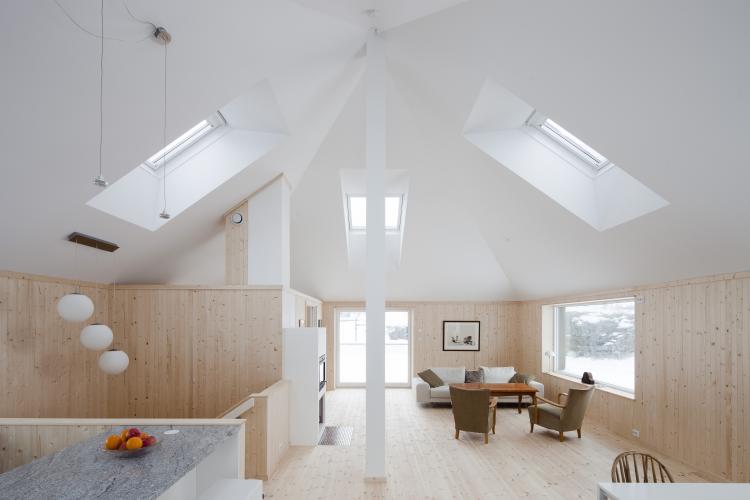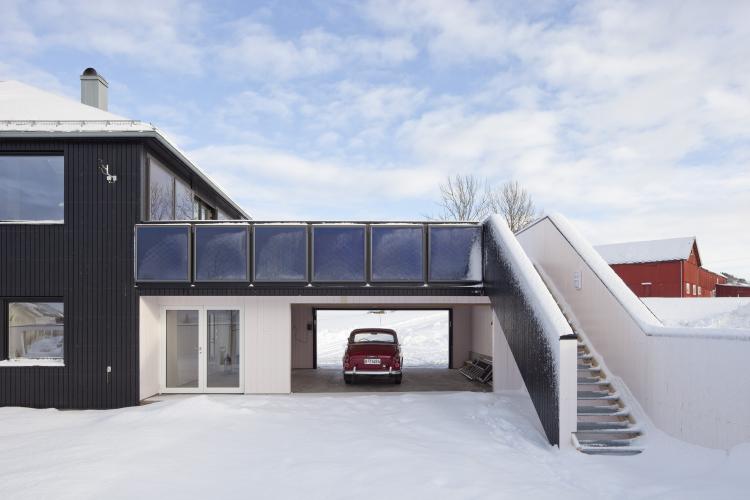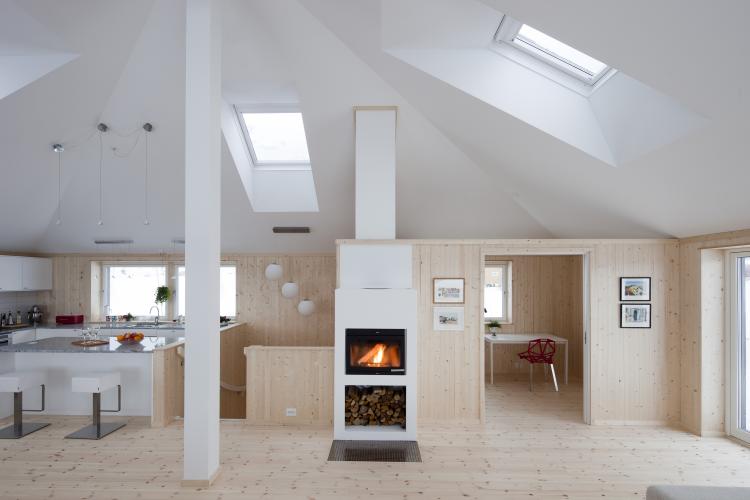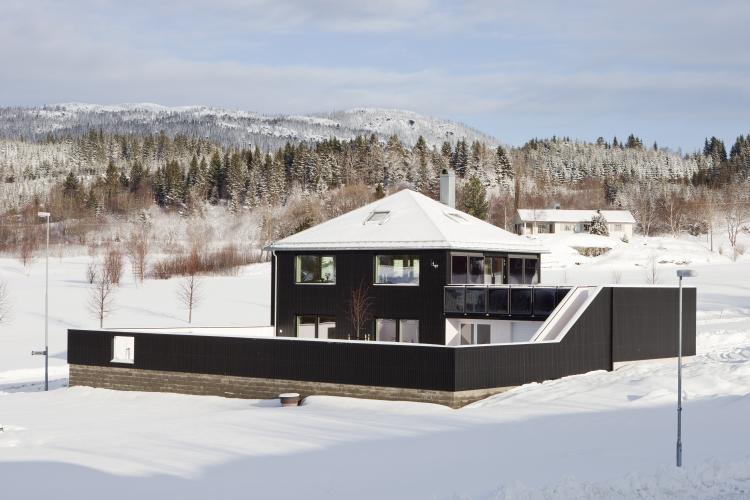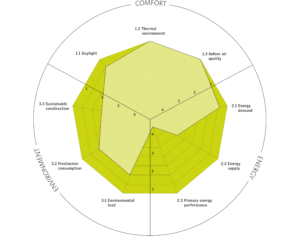Future Active House Norway
The Future Active House in Norway is a modern family home and a showcase of innovative solutions. Its aim is to show that energy efficiency is compatible with a healthy and comfortable living environment
ENERGY:
Future Active House includes a range of energy-efficient technologies following a two-way strategy: to minimize energy consumption while maximizing the role of renewable sources in energy supply. The energy saving initiatives include:
- exterior walls with a U-value of 0.12. They are constructed with a framework with 350 mm glass wool insulation
- roof with a U-value of 0.10, insulated by 500 mm Glava Extrem laid in four different layers, eliminating thermal bridges
- extensive use of windows in both roof and walls enabling the residents to make use of the daylight and solar heat, and reducing the need for electrical lighting. Roof windows are electrically operated and have 3-layer panes, are equipped with external screening (MML) to avoid overheating on hot days and with internal screening (DML) to reduce heat loss on cold days. Roof windows have a U-value of 1.0. Facade windows, balcony door and entrance door have a U-value of 0.7
- that the house is airtight – achieved a very good result in door blower test – 0.3
- natural ventilation
- 18.5 m2 of solar collectors placed vertically on south-east facade and railing. They will cover approximately 50% of the hot water required for the house yearly. In addition they will provide hot water for the hydronic heating system in the entrance area and bathroom
- environmental friendly, low-emission certified wood stoves that contribute to the heating: free standing wood stove on the ground floor and fire insert on the first floor (CO2 emission 10%, emission of particles < 20 mg/Nm3, thermal output 5 kW, energy efficiency 82%)
- energy-efficient heater supplying domestic hot water in the cold season
- KNX system that monitors and manages building equipment and functions such as sunscreens, ventilation, lighting and temperature control. Correct operation and control can bring about significant energy savings (40-60%) for all these functions
- heat recovery system delivered by Swegon (CASA R120): an air handling unit with rotary heat exchanger, airflows up to 430 m³/h, maximum air flow of 120 l/s. It recovers more than 80% of the heat from the exhaust air
- that all lighting in the active house is based on LED light delivered by SG.
- The house will be classified as energy rating A.
INDOOR CLIMATE:
Careful design and state-of the-art technology provide the house with a healthy and comfortable indoor climate, while the extensive use of windows allows residents to enjoy the benefits of daylight from all directions. The house is designed to be light, simple and flexible.
Daylight:
Generous amounts of daylight can improve the living environment in a building and reduce the need for electrical lighting, thereby saving energy. Future Active House is designed with an eye to optimal daylight conditions and the large windows ensure excellent light conditions in all ground level rooms. On the first floor, the main room has four facade windows and four roof windows.
“When there is light coming from all directions, the residents can sense the progression of the day. They can feel the rhythm of nature and seasons.”
Ventilation:
Hybrid ventilation has been implemented in the Future Active House.
A combination of windows and climate control technology ensures natural ventilation, pleasant indoor temperatures and good air quality: four roof windows and four facade windows are automatically controlled. Based on air quality data from sensors monitoring humidity, temperature and CO2 levels in the house, the roof windows open and close automatically. In the winter, mechanical ventilation takes fresh outdoor air into the house and preheats it in a heat exchanger (using a heat recovery system). As soon as the temperature allows, the system switches back to natural ventilation.
The following components are fitted to the unit and the ventilating system:
– Fireplace switch ensures that when a fireplace is lit, air input is compensated for a given time. This reduces the negative air pressure in the house, optimizes the chimney draught and prevents smoke from coming into the room.
– Low pressure compensator is installed in external outlets such as the kitchen ventilator. A pressure sensor is placed in a channel above the ventilator. When the ventilator is switched on during cooking activities, the air input of the aggregate is increased and the output is reduced to help compensate for low pressure.
– A switch at the entrance allows the residents to turn ventilation to a minimum when the house is not occupied.
– Air exhauster on the roof has been prepared and a hood fitted. An extra air exhauster can facilitate additional intake of fresh air on hot days. It can also ensure quicker and controlled cooling of the house in case of rising temperatures caused by fireplaces or increased activity. The decision about an extra air exhauster will be taken when the house has been monitored and tested for some months.
– Acoustic silencer reduces noise from the fan.
KNX:
Future Active House is equipped with a KNX BUS control system delivered by Instell that monitors and manages the building and its equipment. Thanks to this system, occupants of the house can control lighting, heat, ventilation and other functions from practically every room in the house. All electrically operated equipment can be controlled by touch panels or network units like smart phones and tablets.
The KNX system allows the user to override automatic control. It is a communication network in which sensors (light and motion sensors, weather stations, thermostats, etc.) send messages to actuators like motor valves, relay modules and dimmers which perform the required actions. The system is connected to a two-wire cable (BUS), which transmits information and can also work as additional power supply.
Other KNX features in Future Active House include:
– fire alarm integration
– Master Switch features at both front doors and in the main sleeping room, allowing the residents to switch all lights on or off in the house at the same time
– automatic lowering of the temperature and switching ventilation system to minimum when residents leave the house. The settings can be customised by the residents
– fire switch that makes it easier to start the fire in the wooden stoves by increasing the draft
– hot-room controller with integrated thermostat in all rooms
– outdoor lighting equipped with photocell and temperature sensor to display outdoor temperature in all rooms
– automatic water shut-off with 4-hour delay when the functions “gone” or “vacation” are activated.
ENVIRONMENT:
Future Active House is designed to enable the residents to make active use of the surrounding nature and local community. It is located near Trondheim in a region surrounded by mountains. It is built on a south-facing mountainside in the village of Stjørdal. From the house, the residents overlook the Trondheim fjord and enjoy the proximity to golf courses. This all adds up to an excellent location for a project with the ambition to prove how energy efficiency is compatible with values such as light, air and closeness to nature.
For the construction of the house, a lot of local, renewable materials were used and the need for transport and on-site processing was reduced. Furthermore, it is part of the vision that the environment friendly house must be easily adapted to regional conditions. So the construction of Future Active House was in the hands of local businesses.
Black wood cladding, which refers to tradition, covers the facades. The interior walls of Future Active House are covered with wood panels of light spruce.
Future Active House draws on traditional Norwegian architecture and modern solutions. It strives to create and test solutions that are applicable to new constructions as well as existing buildings.

